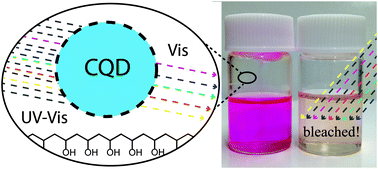Direct synthesis of carbon quantum dots in aqueous polymer solution: one-pot reaction and preparation of transparent UV-blocking films†
Abstract
Carbon quantum dots (CQDs) were characterized and their synthesis optimized extensively over recent years. It is becoming more and more important to develop synthesis solutions for CQDs applications to allow simple and cheap applications with composite materials. Here, we present a one-pot CQDs reaction in an aqueous polyvinyl alcohol (PVA) solution and the synthesis of transparent UV protection films. The synthesis solution was tuned in a way that transparent UV-protection films cast from unpurified CQDs–PVA solutions could be obtained without the need of yield consuming purification steps. Measuring the impact of varying PVA, branched polyethylene imine (b-PEI), and citric acid (CA) concentrations on the solution's and film's UV/Vis transmission and absorbance allowed elucidating important factors influencing the solution to film property transition. Applying CQDs–PVA films on commercially available PET bottle films resulted in high transparency of the composite film in the visible range (>80%) and UV absorption of over 90%. Lastly, our CQDs–PVA film performed stable UV-blocking and did not show any bleaching effects over several days of UV-exposure.



 Please wait while we load your content...
Please wait while we load your content...